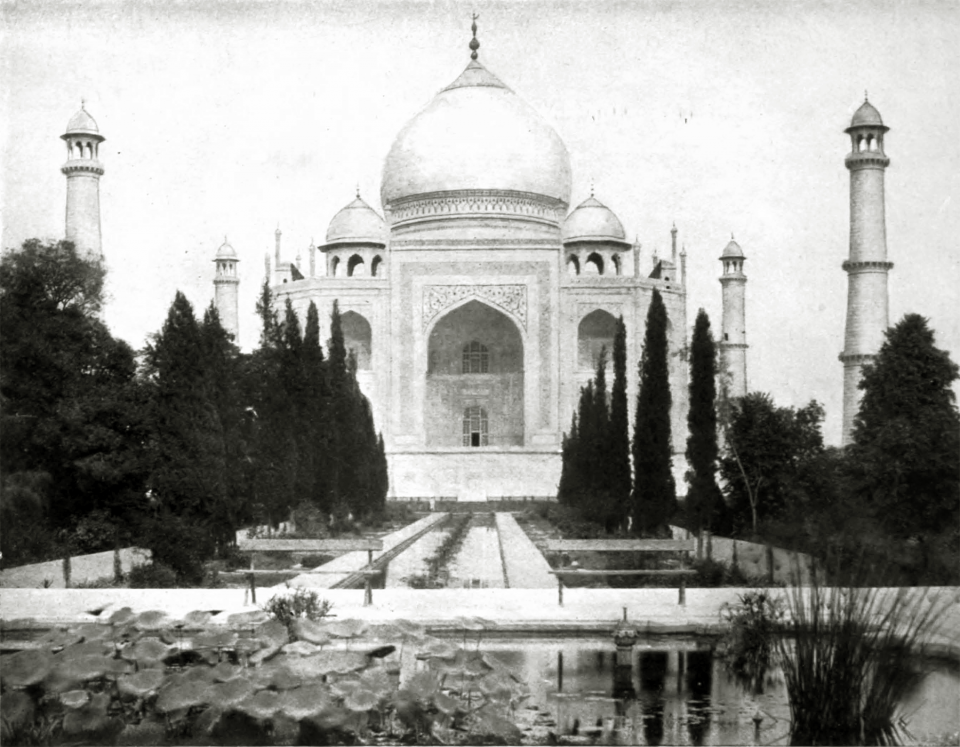A HANDBOOK TO AGRA AND THE TAJ SIKANDRA, FATEHPUR-SIKRI, AND THE NEIGHBOURHOOD
BY E. B. HAVELL, A.R.C.A.
PRINCIPAL, GOVERNMENT SCHOOL OF ART, CALCUTTA
FELLOW OF THE CALCUTTA UNIVERSITY
WITH 14 ILLUSTRATIONS FROM PHOTOGRAPHS AND 4 PLANS
CONTENTS
| PAGE | |
HISTORICAL INTRODUCTION The Great Moguls—I. Babar—Babar's Connection with Agra—II. Humayun—Interregnum: Shere Shah—III. Akbar—Akbar's Connection with Agra—IV. Jahangir—Jahangir's Connection with Agra—V. Shah Jahan—The Monuments of Shah Jahan's Reign at Agra—VI. Aurangzîb—Agra and the Later Mogul Emperors—Agra in the Mutiny. | 3 |
THE FORT The Mûti Masjid—The Dersane Darwaza—The Dîwan-i-âm—Jahangir's Cistern—The Tomb of Mr. Colvin—The Inner Mîna Bazar—The Chitore Gates—The Hindu Temple—The Machhi Bhawan—The Najina Masjid—The Dîwan-i-Khas—Jahangir's Throne—The Baths—The Samman Burj—The Khas Mahal—The Underground Chambers—The Anguri Bagh—Shish Mahal—The "Somnath" Gates—The Jahangiri Mahal—The Sahmgarh. | 40 |
THE JÂMI MASJID | 68 |
THE TAJ The building of the Taj—The Intention of the Taj—Description. | 71 |
ITMÂD-UD-DAULAH'S TOMB | 85 |
THE CHÎNÎ-KA-RAUZA | 91 |
THE RAM BAGH The Zuhara Bagh. | 92 |
SIKANDRA Akbar's Tomb—The Kanch Mahal—Suraj-Bhan-ka Bagh—Mariam Zâmâni's Tomb. | 96 |
OTHER BUILDINGS AND TOMBS AT OR NEAR AGRA The Kali Masjid—Alawal Bilawal—The Hamman—The Roman Catholic Cemetery. | 102 |
FATEHPUR SIKRI The Agra Gate—The Naubat Khana—The Mint—The Daftar Khana—The Palace—The Kwâbgâh—The Turkish Sultana's House—Hakim's Baths—Pachisi Board—The Dîwan-i-Khâs—The Ankh-Michauli—The Yogi's Seat—The Hospital—The Dîwan-i-âm—The Panch Mahal—Miriam's Kothi—Jodh Baí's Palace—Rajah Birbal's House, or Birbal's Daughter's House—The Hathi Pol and Adjoining Buildings—The Jâmi Masjid, or Cathedral Mosque—The Baland Darwaza—The Stone-Cutters' Mosque—The Houses of Abul Fazl and Faizi. | 105 |
| Bharatpur and Other Places in the Vicinity of Agra:—Bharatpur—Govardhan—Muttra—Bindrâban. | 133 |
INDEX |
List of Illustrations
- The Taj Mahal (Frontispiece)
- Plate I. A State Document with Shah Jahan's "Royal Hand and Seal"
- Plate II. Shah Jahan, From an Old Indian Miniature
- Plate III. The Inner Delhi Gate, or Hathi Pol, Agra Fort
- Plate IV. Marble Balcony, Overlooking the Inner Mîna Bazar, Agra Fort
- Plate V. The Samman Burj, Agra Fort
- Plate VI. Inner Courtyard of the Jahangiri Mahal, Agra Fort
- Plate VII. Marble Screen Enclosing the Tombs of Mumtaz Mahal and Shah Jahan
- Plate VIII. Itmâd-ud-daulah's Tomb, Agra
- Plate IX. Interior of the Upper Pavilion, Itmâd-ud-daulah's Tomb
- Plate X. Marble Sarcophagus on the Upper Story of Akbar's Tomb, Sikandra
- Plate XI. Interior of The Dîwan-i-Khâs, Fatehpur Sikri
- Plate XII. Rajah Birbal's Daughter's House, Fatehpur Sikri
- Plate XIII. The Baland Darwaza, Fatehpur Sikri
Plans
- Agra Fort. Plan of the Palaces
- Fatehpur Sikri. Plan Showing the Position of the Buildings
- Fatehpur Sikri. Plan Showing the Walls and Gates
- Fatehpur Sikri. Plan of Jodh Bai's Palace
LONGMANS, GREEN, AND CO.
39 PATERNOSTER ROW, LONDON
NEW YORK AND BOMBAY
1904
All rights reserved
This little book is not intended for a history or archæological treatise, but to assist those who visit, or have visited, Agra, to an intelligent understanding of one of the greatest epochs of Indian Art. In the historical part of it, I have omitted unimportant names and dates, and only attempted to give such a sketch of the personality of the greatest of the Great Moguls, and of the times in which they lived, as is necessary for an appreciation of the wonderful monuments they left behind them. India is the only part of the British Empire where art is still a living reality, a portion of the people’s spiritual possessions. We, in our ignorance and affectation of superiority, make efforts to improve it with Western ideas; but, so far, have only succeeded in doing it incalculable harm. It would be wiser if we would first attempt to understand it.
Among many works to which I owe valuable information, I should name especially Erskine’s translation of Babar’s “Memoirs;” Muhammad Latifs “Agra, Historical and Descriptive;” and Edmund Smith’s “Fatehpur-Sikri.” My acknowledgments are due to Babu Abanindro Nath Tagore, Mr. A. Polwhele, Executive Engineer, Agra, and to Mr. J.H. Marshall, Director-General of the Archæological Survey of India, for kind assistance rendered. I am particularly indebted to Messrs. Johnston and Hoffman, of Calcutta, for allowing me to make use of their valuable collection of photographs for the illustrations.
In quoting from “Bernier’s Travels,” I have used Constable’s translation, with Messrs. A. Constable & Co.’s kind permission. To the Editor of the Nineteenth Century and After I owe permission to make use of my article on “The Taj and its Designers,” published in that Review, June, 1903.
CALCUTTA,
January, 1904.
